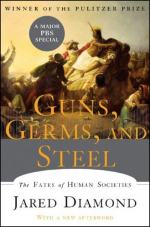
|
| Name: _________________________ | Period: ___________________ |
This test consists of 15 multiple choice questions and 5 short answer questions.
Multiple Choice Questions
1. Where were the earliest known stone tools with ground edges found?
(a) Australia
(b) Africa
(c) Asia
(d) Europe
2. What does Diamond attribute the differences in development to?
(a) The environment
(b) Genetics
(c) Intelligence
(d) Culture
3. China has how many "big" languages?
(a) 8
(b) 5
(c) 2
(d) 12
4. Where does Diamond believe that more research needs to be done?
(a) How racial differences influence development
(b) How intelligence differences influence development
(c) How cultural differences influence development
(d) How biological differences influence development
5. Recent research shows that crops from Mexico spread into eastern North America via an indirect route through where?
(a) Peru
(b) The southwest
(c) Australia
(d) Canada
6. What is the first stage in the transition of diseases to humans?
(a) Humans pick up germs and diseases from pets and domestic animals but the germs are still only passed from animal to human, not between humans.
(b) The major epidemic disease becomes confined to humans.
(c) Humans pick up the diseases from other humans.
(d) Pathogens establish themselves in humans and the disease does not die out.
7. Africa is home to how many major human groups?
(a) 25
(b) 10
(c) 5
(d) 2
8. Which type of society uses a monopoly of force?
(a) Chiefdoms
(b) Tribes
(c) States
(d) Bands
9. Diamond argues that European conquest of Africa had nothing to do with what?
(a) Accidents of geography
(b) Biogeography
(c) Racial superiority
(d) Superior weapons
10. Who invented things like firearms and steel equipment?
(a) Australians
(b) Americans
(c) Eurasians
(d) Africans
11. What is a benefit that institutionalized religion provides?
(a) A way to redistribute money from the wealthy to the poor
(b) Frameworks for unrelated individuals to live together without killing each other
(c) Organizing societies by biological race
(d) The ability to rid a society of evil spirits
12. Cultural and individual idiosyncrasies throw what into the course of history?
(a) The knowledge that these aspects don't matter in history
(b) Certainty
(c) Wild cards
(d) The ability to predict outcomes
13. Australia was once joined together what what other land mass?
(a) Greenland
(b) Cuba
(c) New Guinea
(d) England
14. Why do pockets of the three language families other than Sino-Tibetan exist in China?
(a) They conquered the Sino-Tibetan speakers from 2000 B.C. to 1500 A.D.
(b) Sino-Tibetan speakers replaced or absorbed the other language areas.
(c) Scholars kept the language families alive in the monasteries.
(d) The areas that they are in are frequented by Indonesian traders.
15. Archeological evidence links what early culture with later Pacific island cultures?
(a) Japan
(b) Taiwan
(c) Cherokee
(d) Indian
Short Answer Questions
1. What is not a cause in the uneven distribution of wealth and power, according to Diamond?
2. The basic writing strategy employed by most people today is which of the following?
3. How many "little" languages does China have?
4. Where did writing develop?
5. Diamond argues that China is which of the following?
|
This section contains 464 words (approx. 2 pages at 300 words per page) |

|




